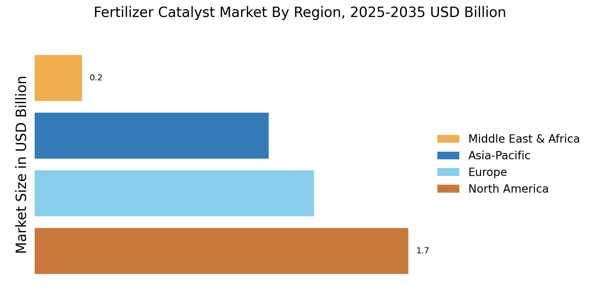Environmental Regulations
The implementation of stringent environmental regulations is shaping the Fertilizer Catalyst Market. Governments worldwide are increasingly focusing on sustainable agricultural practices to mitigate the environmental impact of fertilizers. Regulations aimed at reducing nitrogen runoff and promoting the use of eco-friendly fertilizers are becoming more common. This shift necessitates the development of catalysts that can facilitate the production of environmentally friendly fertilizers. Market analysis suggests that compliance with these regulations could drive a 15% increase in demand for innovative fertilizer catalysts over the next five years. Thus, the Fertilizer Catalyst Market is poised for growth as manufacturers adapt to these regulatory changes and invest in sustainable solutions.
Rising Agricultural Demand
The increasing The Fertilizer Catalyst Industry. As agricultural practices evolve to meet these demands, the need for efficient fertilizers becomes paramount. Fertilizer catalysts enhance the efficiency of nutrient uptake in plants, thereby maximizing yield. According to recent data, the agricultural sector is projected to grow at a compound annual growth rate of approximately 3.5% over the next decade. This growth is likely to spur investments in fertilizer technologies, including catalysts, which are essential for optimizing fertilizer formulations. Consequently, the Fertilizer Catalyst Market is expected to witness substantial growth as farmers seek to improve productivity while minimizing environmental impact.
Innovations in Fertilizer Production
Technological advancements in fertilizer production processes are significantly influencing the Fertilizer Catalyst Market. Innovations such as precision agriculture and the development of slow-release fertilizers are becoming increasingly prevalent. These technologies require specialized catalysts to enhance their effectiveness. For instance, the introduction of new catalytic processes can reduce energy consumption and improve the overall efficiency of fertilizer production. Market data indicates that the adoption of advanced fertilizer technologies could lead to a reduction in production costs by up to 20%. As a result, the Fertilizer Catalyst Market is likely to expand as manufacturers invest in research and development to create more efficient catalysts that align with modern agricultural practices.
Growing Awareness of Sustainable Practices
The rising awareness of sustainable agricultural practices among consumers and farmers is influencing the Fertilizer Catalyst Market. As consumers demand more environmentally friendly products, farmers are compelled to adopt practices that minimize ecological footprints. Fertilizer catalysts play a vital role in this transition by enhancing the efficiency of fertilizers, thereby reducing the amount needed for optimal crop yields. Market trends indicate that the demand for sustainable fertilizers is expected to grow by 25% over the next five years. This shift towards sustainability is likely to drive the Fertilizer Catalyst Market as manufacturers respond to consumer preferences and invest in developing catalysts that support sustainable farming practices.
Increased Investment in Agricultural Technology
The surge in investment in agricultural technology is a key driver for the Fertilizer Catalyst Market. Venture capital and government funding are increasingly directed towards innovations that enhance agricultural productivity. This influx of capital is likely to accelerate the development of advanced fertilizer catalysts that improve nutrient efficiency and reduce waste. Recent reports indicate that investment in agri-tech is expected to reach $10 billion annually by 2027. Such financial backing is crucial for research and development initiatives aimed at creating cutting-edge catalysts. Consequently, the Fertilizer Catalyst Market stands to benefit from this trend as new technologies emerge to meet the evolving needs of farmers.


















Leave a Comment